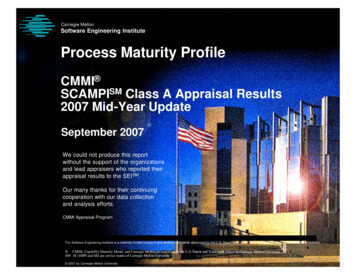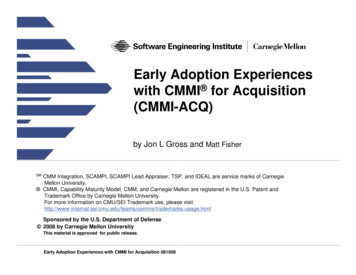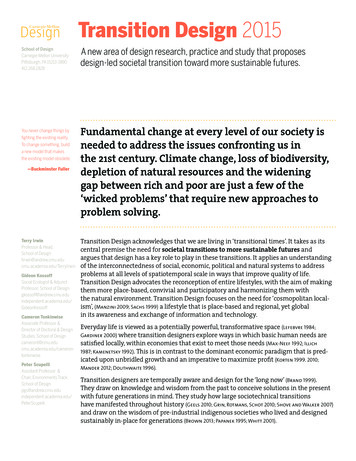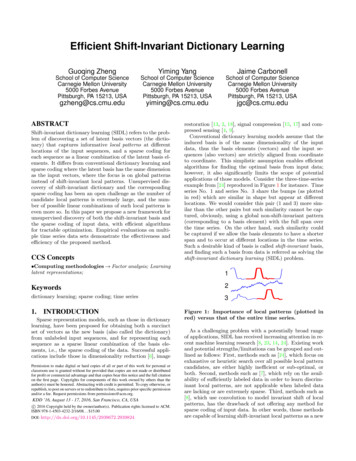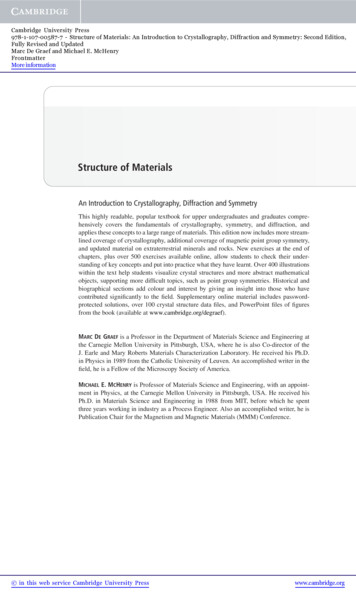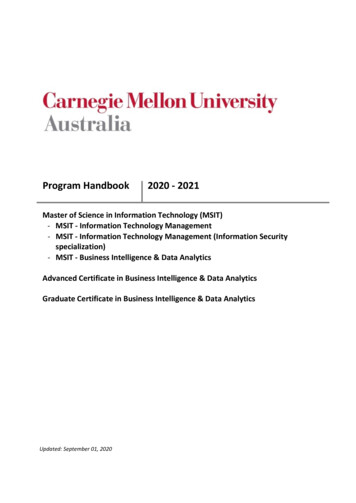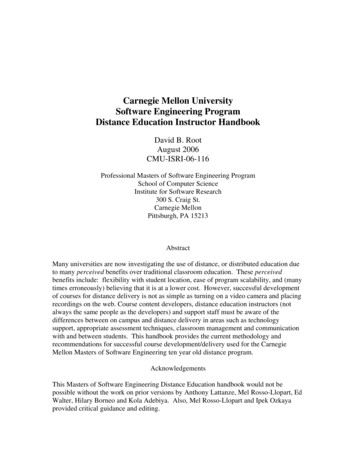
Transcription
Design PatternsPrinciples of Software System ConstructionProf. Jonathan AldrichFall 2011
A First Pattern: Composite (Structural) Applicability– You want to represent part-wholehierarchies of objects– You want to be able to ignore thedifference between compositions ofobjects and individual objects Consequences– Makes the client simple, since it cantreat objects and compositesuniformly– Makes it easy to add new kinds ofcomponents– Can make the design overly general Operations may not make sense onevery class Composites may contain only certaincomponentsDesign PatternsPrinciples of Software System Construction 2011 Jonathan Aldrich2
Design Patterns "Each pattern describes a problem which occurs overand over again in our environment, and thendescribes the core of the solution to that problem, insuch a way that you can use this solution a milliontimes over, without ever doing it the same waytwice”– Christopher Alexander Every Composite has its own domain-specificinterface– But they share a common problem and solutionDesign PatternsPrinciples of Software System Construction 2011 Jonathan Aldrich3
History Christopher Alexander, The Timeless Way of Building (andother books– Proposes patterns as a way of capturing design knowledge inarchitecture– Each pattern represents a tried-and-true solution to a design problem– Typically an engineering compromise that resolves conflicting forces inan advantageous way Composite: you have a part-whole relationship, but want to treatindividual objects and object compositions uniformlyDesign PatternsPrinciples of Software System Construction 2011 Jonathan Aldrich4
Patterns in Physical Architecture When a room has a window with a view, the window becomesa focal point: people are attracted to the window and want tolook through it. The furniture in the room creates a secondfocal point: everyone is attracted toward whatever point thefurniture aims them at (usually the center of the room or aTV). This makes people feel uncomfortable. They want to lookout the window, and toward the other focus at the same time.If you rearrange the furniture, so that its focal point becomesthe window, then everyone will suddenly notice that the roomis much more “comfortable”.– Leonard Budney, Amazon.com review of The Timeless Wayof BuildingDesign PatternsPrinciples of Software System Construction 2011 Jonathan Aldrich5
Benefits of Patterns Shared language of design– Increases communication bandwidth– Decreases misunderstandings Learn from experience– Becoming a good designer is hard Understanding good designs is a first step– Tested solutions to common problems Where is the solution applicable? What are the tradeoffs?Design PatternsPrinciples of Software System Construction 2011 Jonathan Aldrich6
Illustration [Shalloway and Trott] Carpenter 1: How do you think we should build thesedrawers? Carpenter 2: Well, I think we should make the joint by cuttingstraight down into the wood, and then cut back up 45degrees, and then going straight back down, and then back upthe other way 45 degrees, and then going straight down, andrepeating Design PatternsPrinciples of Software System Construction 2011 Jonathan Aldrich7
Illustration [Shalloway and Trott] Carpenter 1: How do you think we should build thesedrawers? Carpenter 2: Well, I think we should make the joint by cuttingstraight down into the wood, and then cut back up 45degrees, and then going straight back down, and then back upthe other way 45 degrees, and then going straight down, andrepeating SE example: “I wrote this if statement to handle followed bya while loop with a break statement so that ”Design PatternsPrinciples of Software System Construction 2011 Jonathan Aldrich8
A Better Way Carpenter 1: Should we use a dovetail joint or a miterjoint? Subtext:– miter joint: cheap, invisible, breaks easily– dovetail joint: expensive, beautiful, durable Shared terminology and knowledge of consequencesraises level of abstraction– CS: Should we use a Composite?– Subtext Is there a part-whole relationship here? Might there be advantages to treating compositions andindividuals uniformly?Design PatternsPrinciples of Software System Construction 2011 Jonathan Aldrich9
Elements of a Pattern Name– Important because it becomes part of a design vocabulary– Raises level of communication Problem– When the pattern is applicable Solution– Design elements and their relationships– Abstract: must be specialized Consequences– Tradeoffs of applying the pattern Each pattern has costs as well as benefits Issues include flexibility, extensibility, etc. There may be variations in the pattern with different consequencesDesign PatternsPrinciples of Software System Construction 2011 Jonathan Aldrich10
History: Design Patterns Book Brought Design Patterns into themainstream Authors known as the Gang ofFour (GoF) Focuses on descriptions ofcommunicating objects and classesthat are customized to solve ageneral design problem in aparticular context Great as a reference text Uses C , SmalltalkDesign PatternsPrinciples of Software System Construction 2011 Jonathan Aldrich11
A More Recent Patterns Text Uses Java– The GoF text was writtenbefore Java wentmainstream Good pedagogically– General design information– Lots of examples andexplanation– GoF is really more areference text Read it!Design PatternsPrinciples of Software System Construction 2011 Jonathan Aldrich12
Fundamental OO Design Principles Patterns emerge from fundamental principles applied torecurring problems– Design to interfaces– Favor composition over inheritance– Find what varies and encapsulate itDesign PatternsPrinciples of Software System Construction 2011 Jonathan Aldrich13
Introduction to Patterns Categories– Structural – vary object structure– Behavioral – vary the behavior you want– Creational – vary object creation Derived from scenarios– Experienced students: please don’t jump straight to the pattern UML diagram credit: Pekka Nikander– http://www.tml.tkk.fi/ pnr/GoF-models/html/Design PatternsPrinciples of Software System Construction 2011 Jonathan Aldrich14
Patterns to Know Façade, Adapter, Composite, Strategy, Bridge, AbstractFactory, Factory Method, Decorator, Observer, TemplateMethod, Singleton, Command, State, Proxy, and Model-ViewController Know pattern name, problem, solution, and consequencesDesign PatternsPrinciples of Software System Construction 2011 Jonathan Aldrich15
Specific PatternsDesign PatternsPrinciples of Software System Construction 2011 Jonathan Aldrich16
Scenario You need to load and printpictures in your application You found a library that providesfar more than you need– Many classes– Different representations– Sophisticated imagemanipulation routines You may want to switch to adifferent library later What’s the right design?Design PatternsPrinciples of Software System Construction 2011 Jonathan Aldrich17
Façade (Structural) Applicability– You want to provide a simpleinterface to a complex subsystem– You want to decouple clients fromthe implementation of a subsystem– You want to layer your subsystems Consequences– It shields clients from the complexityof the subsystem, making it easier touse– Decouples the subsystem and itsclients, making each easier to change– Clients that need to can still accesssubsystem classesDesign PatternsPrinciples of Software System Construction 2011 Jonathan Aldrich18
Scenario You have an application thatprocesses data with an Iterator.Methods are:– boolean hasNext();– Object next(); You need to read that data from adatabase using JDBC. Methods are:– boolean next();– Object getObject(int column); You might have to get theinformation from other sources inthe future.Design PatternsPrinciples of Software System Construction 2011 Jonathan Aldrich19
Structural: Adapter Applicability– You want to use an existing class, andits interface does not match the oneyou need– You want to create a reusable classthat cooperates with unrelatedclasses that don’t necessarily havecompatible interfaces– You need to use several subclasses,but it’s impractical to adapt theirinterface by subclassing each one Consequences– Exposes the functionality of anobject in another form– Unifies the interfaces of multipleincompatible adaptee objects– Lets a single adapter work withmultiple adaptees in a hierarchyDesign PatternsPrinciples of Software System Construction 2011 Jonathan Aldrich20
Back to Fundamental Principles Design to interfaces– Façade – a new interface for a library– Adapter – design application to a common interface, adapt otherlibraries to that Favor composition over inheritance– Façade – library is composed within Façade– Adapter – adapter object interposed between client andimplementation Find what varies and encapsulate it– Both Façade and Adapter – shields variations in the implementationfrom the clientDesign PatternsPrinciples of Software System Construction 2011 Jonathan Aldrich21
Façade vs. Adapter Motivation– Façade: simplify the interface– Adapter: match an existing interface Adapter: interface is given– Not typically true in Façade Adapter: polymorphic– Dispatch dynamically to multiple implementations– Façade: typically choose the implementation staticallyDesign PatternsPrinciples of Software System Construction 2011 Jonathan Aldrich22
Scenario Context: eCommerce application– Cart object holds Items Problem: how to compute taxes?– State sales tax– Local sales tax– Differing exemptions– How can we make the taxationalgorithm easy to change?Design PatternsPrinciples of Software System Construction 2011 Jonathan Aldrich23
Behavioral: Strategy Applicability– Many classes differ in only theirbehavior– Client needs different variantsof an algorithm Consequences– Code is more extensible withnew strategies Compare to conditionals– Separates algorithm fromcontext each can vary independently– Adds objects and dynamism code harder to understand– Common strategy interface may not be needed for all Strategyimplementations – may be extraoverheadDesign PatternsPrinciples of Software System Construction 2011 Jonathan Aldrich24
Back to Fundamental Principles Design to interfaces– Strategy: the algorithm interface Favor composition over inheritance– Strategy could be implemented with inheritance Multiple subclasses of Context, each with an algorithm Drawback: couples Context to algorithm, both become harder to change Drawback: can’t change algorithm dynamically Find what varies and encapsulate it– Strategy: the algorithm used Side note: how do you implement the Strategy pattern infunctional languages?Design PatternsPrinciples of Software System Construction 2011 Jonathan Aldrich25
Scenario Shape graphics library– rectangles, circles, squares– extensible to more shapes Need flexible implementation– Java Swing– Eclipse SWT– Printing libraries, etc. How can we allow both:– extension with new shapes– adaptation to new back ends?Design PatternsPrinciples of Software System Construction 2011 Jonathan Aldrich26
Structural: Bridge Applicability– Want to define multipleabstractions– Need to implement in multipleways Consequences– Avoid blow-up in number ofclasses– Decouples abstraction fromimplementation Choose each separately, even atrun time Extend each independently– Hide implementation fromclients– Requires fixed implementationinterfaceDesign PatternsPrinciples of Software System Construction 2011 Jonathan Aldrich27
Scenario Context: Window library– Multiple kinds of windows– Multiple implementation families(by library, OS, etc.)– Bridge pattern Problem: how to create theimplementation objects?– Avoid tying window interface toparticular back ends– Back ends must work together(no mixing Swing and SWTcomponents)Design PatternsPrinciples of Software System Construction 2011 Jonathan Aldrich28
Creational: Abstract factory Applicability– System should be independentof product creation– Want to configure withmultiple families of products– Want to ensure that a productfamily is used together Consequences– Isolates concrete classes– Makes it easy to changeproduct families– Helps ensure consistent use offamily– Hard to support new kinds ofproductsDesign PatternsPrinciples of Software System Construction 2011 Jonathan Aldrich29
Scenario You have global data & operations– Must be used consistently withinthe app– Might be changed later– Don’t want to pass aroundexplicitly No good existing place to create andstore the objectDesign PatternsPrinciples of Software System Construction 2011 Jonathan Aldrich30
Creational: Singleton Applicability– There must be exactly one instanceof a class– When it must be accessible to clientsfrom a well-known place– When the sole instance should beextensible by subclassing, withunmodified clients using the subclass Consequences– Controlled access to sole instance– Reduced name space (vs. globalvariables)– Can be refined in subclass orchanged to allow multiple instances– More flexible than class operations Can change later if you need toDesign Patterns Implementation– Constructor is protected– Instance variable is private– Public operation returns singleton May lazily create singleton Subclassing– Instance() method can look upsubclass to create in environmentPrinciples of Software System Construction 2011 Jonathan Aldrich31
Behavioral: Observer Applicability– When an abstraction has twoaspects, one dependent on theother, and you want to reuse each– When change to one object requireschanging others, and you don’t knowhow many objects need to bechanged– When an object should be able tonotify others without knowing whothey are Consequences– Loose coupling between subject andobserver, enhancing reuse– Support for broadcastcommunication– Notification can lead to furtherupdates, causing a cascade effectDesign PatternsPrinciples of Software System Construction 2011 Jonathan Aldrich32
Behavioral: Template Method Applicability– When an algorithm consists ofvarying and invariant parts that mustbe customized– When common behavior insubclasses should be factored andlocalized to avoid code duplication– To control subclass extensions tospecific operations Consequences– Code reuse– Inverted “Hollywood” control: don’tcall us, we’ll call you– Ensures the invariant parts of thealgorithm are not changed bysubclassesDesign PatternsPrinciples of Software System Construction 2011 Jonathan Aldrich33
Creational: Factory Method Applicability– A class can’t anticipate theclass of objects it mustcreate– A class wants its subclassesto specify the objects itcreatesDesign Patterns Consequences– Provides hooks forsubclasses to customizecreation behavior– Connects parallel classhierarchiesPrinciples of Software System Construction 2011 Jonathan Aldrich34
Structural: Decorator Applicability– To add responsibilities toindividual objectsdynamically andtransparently– For responsibilities that canbe withdrawn– When extension bysubclassing is impractical Consequences– More flexible than staticinheritance– Avoids monolithic classes– Breaks object identity– Lots of little objectsDesign PatternsPrinciples of Software System Construction 2011 Jonathan Aldrich35
Structural: Proxy Applicability– Whenever you need a moresophisticated object referencethan a simple pointer Local representative for a remoteobject Create or load expensive object ondemand Control access to an object Reference count an object Consequences– Introduces a level of indirection Hides distribution from client Hides optimizations from client Adds housekeeping tasksDesign PatternsPrinciples of Software System Construction 2011 Jonathan Aldrich36
Behavioral: Mediator Applicability– A set of objects that communicate inwell-defined but complex ways– Reusing an object is difficult becauseit communicates with others– A behavior distributed betweenseveral classes should becustomizable without a lot ofsubclassing Consequences– Avoids excessive subclassing tocustomize behavior– Decouples colleagues, enhancingreuse– Simplifies object protocols: many-tomany to one-to-many– Abstracts how objects cooperate intothe mediator– Centralizes control Danger of mediator monolithDesign PatternsPrinciples of Software System Construction 2011 Jonathan Aldrich37
Behavioral: Command Applicability– Parameterize objects by an action toperform– Specify, queue and execute requestsat different times– Support undo– Support logging changes that can bereapplied after a crash– Structure a system around high-leveloperations built out of primitives Consequences– Decouples the object that invokesthe operation from the one thatperforms it– Since commands are objects theycan be explicitly manipulated– Can group commands into compositecommands– Easy to add new commands withoutchanging existing codeDesign PatternsPrinciples of Software System Construction 2011 Jonathan Aldrich38
Behavioral: Visitor Applicability– Structure with many classes– Want to perform operationsthat depend on classes– Set of classes is stable– Want to define new operations Consequences– Easy to add new operations– Groups related behavior inVisitor– Adding new elements is hard– Visitor can store state– Elements must exposeinterfaceDesign PatternsPrinciples of Software System Construction 2011 Jonathan Aldrich39
Other GoF Patterns Creational– Builder – separate creation from representation– Prototype – create objects by copying Structural– Flyweight – use sharing for fine-grained objects Behavioral––––Chain of Responsibility – sequence of objects can respond to a requestInterpreter – canonical implementation techniqueMemento – externalize/restore an object’s stateState – allow object to alter behavior when state changesDesign PatternsPrinciples of Software System Construction 2011 Jonathan Aldrich40
Design Patterns "Each pattern describes a problem which occurs over and over again in our environment, and then describes the core of the solution to that problem, in such a way that you can use this solution a million times over, without ever doing it the same way twice” –Chris

